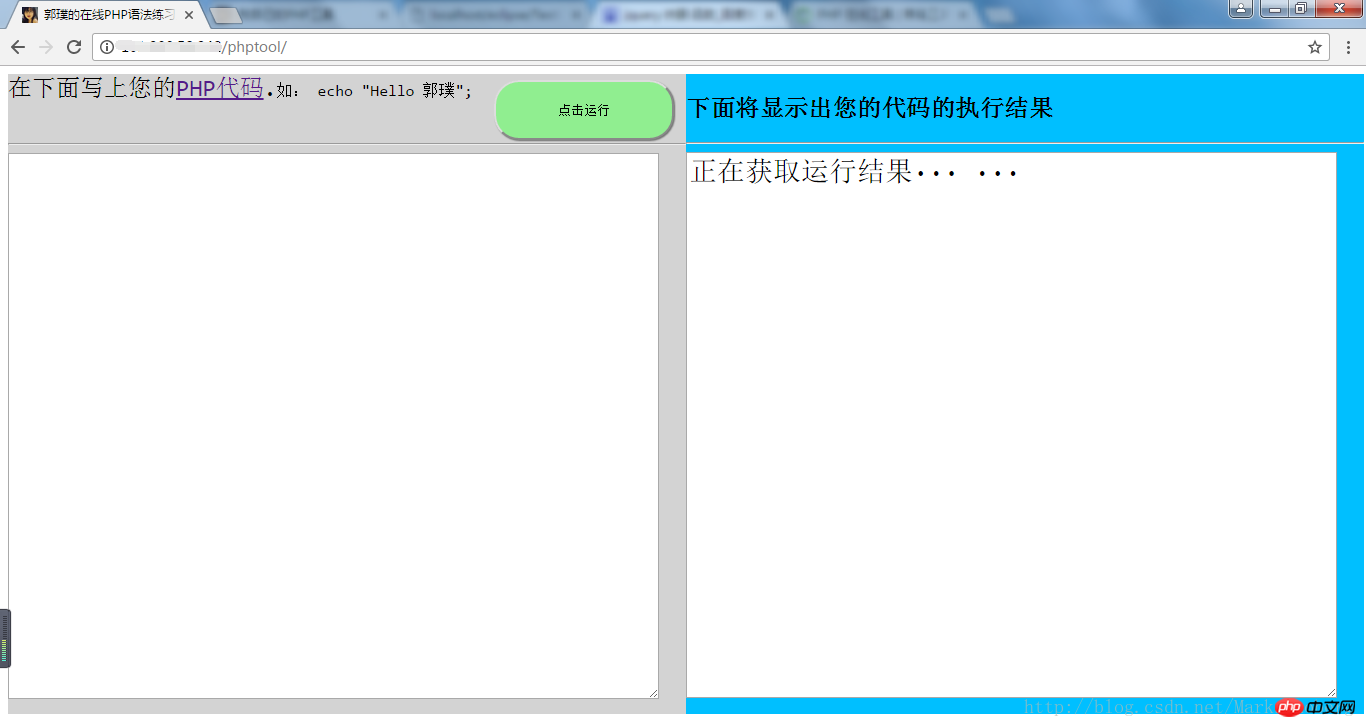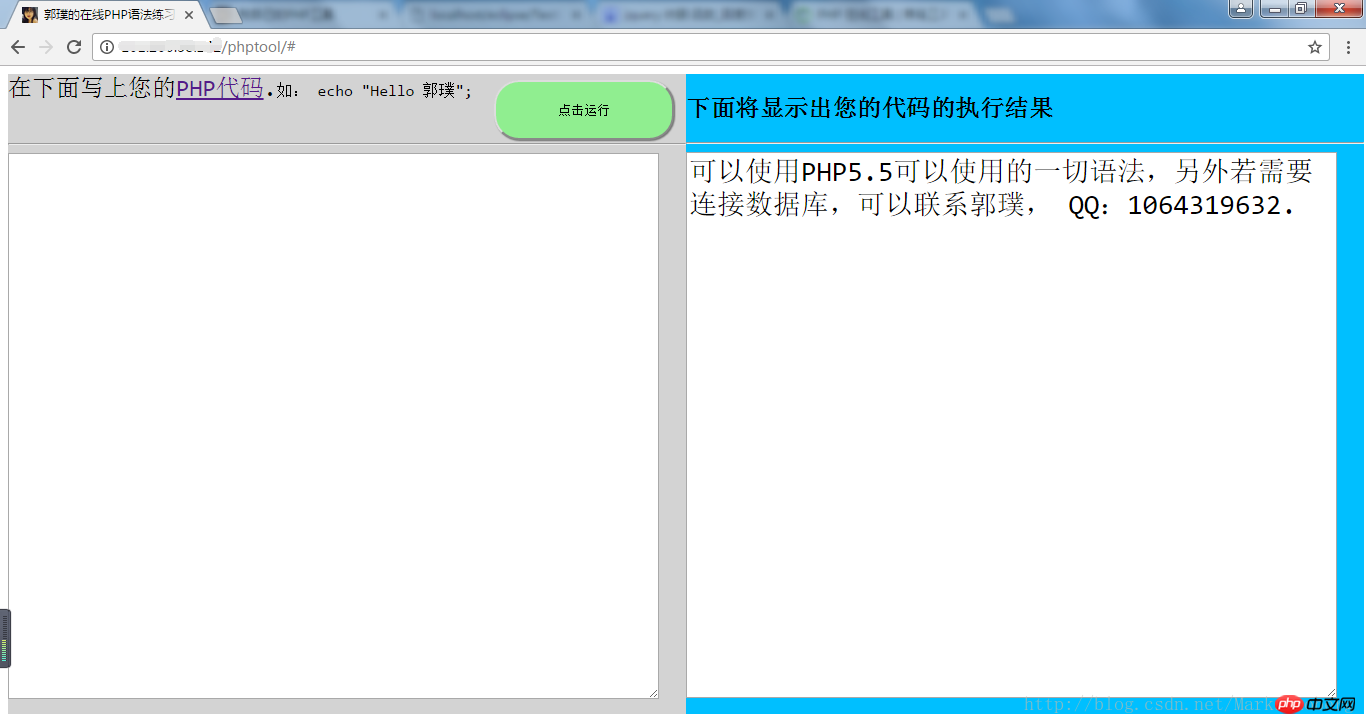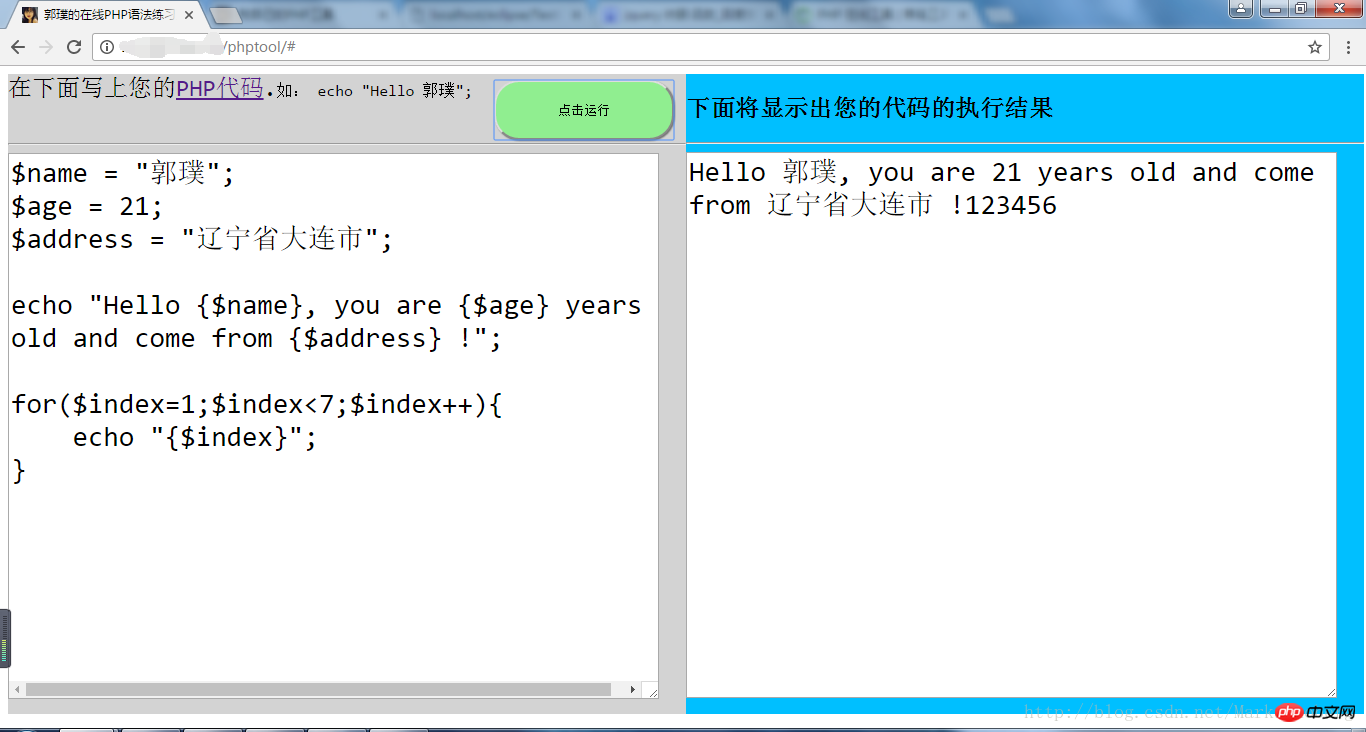 Backend Development
Backend Development
 PHP Tutorial
PHP Tutorial
 Detailed introduction to online PHP running tools and database controllable example codes
Detailed introduction to online PHP running tools and database controllable example codes
Detailed introduction to online PHP running tools and database controllable example codes
As a PHP novice, it would be great if there was a useful tool for practicing grammar anytime and anywhere. Obviously, the above PHP online tool can basically meet normal needs.
But the only drawback is that it does not support databases and other advanced features. So this seems very embarrassing. If you can't practice database statements, you're still learning a lot. So it’s better to do it yourself, write an online tool that can support the database, and use it yourself.
Implementation ideas
For PHP files, when the browser sends a URL request to the server, the interpreter will automatically translate the file into a part that the browser can parse. So the process of accessing the URL is the process of obtaining the data interpreted by PHP.
Brief explanation
The following is a brief explanation. For example, we have such a temp.php file, the content is as follows:
<?php echo "Hello PHP";
When the browser accesses, the data obtained is as follows: 
Tool Principle
Since the above temp.php file can work like this, then just imagine, if we put the file we want to run in the temp.php file in advance, and then access this temp.php file, wouldn't we be able to get it? The desired result.
In fact, this is what I did, and the results proved that if the order is correct, it is quite good.
My idea is:
Give me a button. When the button is clicked, the source code will first be sent to the server, and then an ajax request will be called to run the source code. The results are taken out and displayed on the "console".
Production
The specific implementation process will be introduced below.
main.php
<!DOCTYPE html>
<html>
<head>
<meta charset="UTF-8">
<title>我自己的PHP工具</title>
<link rel="shortcut icon" href="favicon.ico" type="image/x-ico" />
<style>
.container {
width: 1356px;
height: 640px;
position: absolute;
background: #CCC;}
.left {
width: 50%;
height: 100%;
background: lightgray;
position: relative;
float: left;}
.header {
width: auto;
height: 61px;}
input {
width: 180px;
height: 60px;
position: relative;
background: lightgreen;
float: right;
margin-right: 12px;
margin-top: 6px;
border-radius: 25px;
box-shadow: 1px 1px 1px #6e6e6e;}
.panel {
width: 90%;
height: 540px;
align: center;}
textarea {
font-size: 28px;}
.right {
width: 50%;
height: 100%;
background: deepskyblue;
position: relative;
float: right;}
</style>
</head>
<body>
<p class="container">
<p class="left">
<p class="header">
<label><font size="5">在下面写上您的PHP代码.</font>如: echo "Hello 郭璞";</label>
<input id="btn_run" type="submit" value="点击运行"></input>
</p>
<hr>
<p class="panel">
<textarea id="source" style="width: 645px; height: 540px;"
name="source" placeholder="echo 'Hello World!';">
</textarea>
<!-- <textarea type="hidden" id="hidden" hidden></textarea> -->
</p>
</p>
<p class="right">
<h2 id="下面将显示出您的代码的执行结果">下面将显示出您的代码的执行结果</h2>
<hr>
<p class="panel">
<textarea id="result" style="width: 645px; height: 540px;">
</textarea>
</p>
</p>
</p>
<!-- 编写提交脚本,并获取返回结果 -->
<script src="./js/jquery-2.2.4.min.js"></script>
<script>
// 请求运行结果
function getResult() {
$.ajax({
type : "GET",
url : "./temp.php",
success : function(data) {
document.getElementById("result").value = data;
},
error : function(err) {
document.getElementById("result").value = err;
}
});
} // 将源代码上传到服务器上
function uploadSource() {
var source = document.getElementById("source").value;
$.ajax({
type: "POST",
url: "./main.php",
data: {
"source": source
},
success: function(){
console.log("代码上传成功!");
},
error: function(err){
console.log("代码上传失败!");
alert(err);
}
});
} // 使用ajax来 获取执行的结果
$(document).ready(function() {
document.getElementById("result").value = "正在获取运行结果··· ···";
$("#btn_run").click(function(){
// 先上传代码
uploadSource(); // 请求代码运行后的结果
getResult();
});
}); </script>
<!-- 编写php脚本,获取提交信息 -->
<?php
$source = $_POST ['source']; $source = "<?php " . $source;
file_put_contents ( "./temp.php", $source ); ?></body></html>Upload source code
<!-- 编写php脚本,获取提交信息 -->
<?php
$source = $_POST ['source'];
$source = "<?php " . $source;
file_put_contents ( "./temp.php", $source ); ?>After this code, you can upload the edited source code to the specified temp.php on the server, and then The preparation process is over.
ajax
Here ajax plays two roles:
One is to upload the source code
One is to get the code running results
Upload the source code
// 将源代码上传到服务器上
function uploadSource() {
var source = document.getElementById("source").value;
$.ajax({
type: "POST",
url: "./main.php",
data: {
"source": source
},
success: function(){
console.log("代码上传成功!");
},
error: function(err){
console.log("代码上传失败!");
alert(err);
}
});
}Get the running results
// 请求运行结果
function getResult() {
$.ajax({
type : "GET",
url : "./temp.php",
success : function(data) {
document.getElementById("result").value = data;
},
error : function(err) {
document.getElementById("result").value = err;
}
});
}Trigger timing
According to the requirements, only The upload and download process will only be executed when the Run button is clicked. So you only need to add a click event to the button.
$(document).ready(function() {
document.getElementById("result").value = "正在获取运行结果··· ···";
$("#btn_run").click(function(){
// 先上传代码
uploadSource();
// 请求代码运行后的结果
getResult();
});
});Demo
There happens to be an Alibaba Cloud server, so let’s put it on it. In this way, you can have an online PHP environment that can be used normally anytime and anywhere.
Homepage

Click "PHP Code" and a prompt will be given

Regular Code

Operation database

Summary
Finally, to review, this article mainly introduces how to implement a Online PHP editing tool. Satisfy your own needs for operating databases.
Another important point is that the reason why a form is not used is to submit/upload the source code. This is because if you use a form, once it is submitted, all the information on the fields in the original form will disappear, which is not conducive to subsequent code debugging and modification. If you use ajax to submit, there are not so many restrictions, but you can design more freely.
The above is the detailed content of Detailed introduction to online PHP running tools and database controllable example codes. For more information, please follow other related articles on the PHP Chinese website!

Hot AI Tools

Undresser.AI Undress
AI-powered app for creating realistic nude photos

AI Clothes Remover
Online AI tool for removing clothes from photos.

Undress AI Tool
Undress images for free

Clothoff.io
AI clothes remover

Video Face Swap
Swap faces in any video effortlessly with our completely free AI face swap tool!

Hot Article

Hot Tools

Notepad++7.3.1
Easy-to-use and free code editor

SublimeText3 Chinese version
Chinese version, very easy to use

Zend Studio 13.0.1
Powerful PHP integrated development environment

Dreamweaver CS6
Visual web development tools

SublimeText3 Mac version
God-level code editing software (SublimeText3)

Hot Topics
 PHP 8.4 Installation and Upgrade guide for Ubuntu and Debian
Dec 24, 2024 pm 04:42 PM
PHP 8.4 Installation and Upgrade guide for Ubuntu and Debian
Dec 24, 2024 pm 04:42 PM
PHP 8.4 brings several new features, security improvements, and performance improvements with healthy amounts of feature deprecations and removals. This guide explains how to install PHP 8.4 or upgrade to PHP 8.4 on Ubuntu, Debian, or their derivati
 How To Set Up Visual Studio Code (VS Code) for PHP Development
Dec 20, 2024 am 11:31 AM
How To Set Up Visual Studio Code (VS Code) for PHP Development
Dec 20, 2024 am 11:31 AM
Visual Studio Code, also known as VS Code, is a free source code editor — or integrated development environment (IDE) — available for all major operating systems. With a large collection of extensions for many programming languages, VS Code can be c
 Explain JSON Web Tokens (JWT) and their use case in PHP APIs.
Apr 05, 2025 am 12:04 AM
Explain JSON Web Tokens (JWT) and their use case in PHP APIs.
Apr 05, 2025 am 12:04 AM
JWT is an open standard based on JSON, used to securely transmit information between parties, mainly for identity authentication and information exchange. 1. JWT consists of three parts: Header, Payload and Signature. 2. The working principle of JWT includes three steps: generating JWT, verifying JWT and parsing Payload. 3. When using JWT for authentication in PHP, JWT can be generated and verified, and user role and permission information can be included in advanced usage. 4. Common errors include signature verification failure, token expiration, and payload oversized. Debugging skills include using debugging tools and logging. 5. Performance optimization and best practices include using appropriate signature algorithms, setting validity periods reasonably,
 PHP Program to Count Vowels in a String
Feb 07, 2025 pm 12:12 PM
PHP Program to Count Vowels in a String
Feb 07, 2025 pm 12:12 PM
A string is a sequence of characters, including letters, numbers, and symbols. This tutorial will learn how to calculate the number of vowels in a given string in PHP using different methods. The vowels in English are a, e, i, o, u, and they can be uppercase or lowercase. What is a vowel? Vowels are alphabetic characters that represent a specific pronunciation. There are five vowels in English, including uppercase and lowercase: a, e, i, o, u Example 1 Input: String = "Tutorialspoint" Output: 6 explain The vowels in the string "Tutorialspoint" are u, o, i, a, o, i. There are 6 yuan in total
 How do you parse and process HTML/XML in PHP?
Feb 07, 2025 am 11:57 AM
How do you parse and process HTML/XML in PHP?
Feb 07, 2025 am 11:57 AM
This tutorial demonstrates how to efficiently process XML documents using PHP. XML (eXtensible Markup Language) is a versatile text-based markup language designed for both human readability and machine parsing. It's commonly used for data storage an
 Explain late static binding in PHP (static::).
Apr 03, 2025 am 12:04 AM
Explain late static binding in PHP (static::).
Apr 03, 2025 am 12:04 AM
Static binding (static::) implements late static binding (LSB) in PHP, allowing calling classes to be referenced in static contexts rather than defining classes. 1) The parsing process is performed at runtime, 2) Look up the call class in the inheritance relationship, 3) It may bring performance overhead.
 What are PHP magic methods (__construct, __destruct, __call, __get, __set, etc.) and provide use cases?
Apr 03, 2025 am 12:03 AM
What are PHP magic methods (__construct, __destruct, __call, __get, __set, etc.) and provide use cases?
Apr 03, 2025 am 12:03 AM
What are the magic methods of PHP? PHP's magic methods include: 1.\_\_construct, used to initialize objects; 2.\_\_destruct, used to clean up resources; 3.\_\_call, handle non-existent method calls; 4.\_\_get, implement dynamic attribute access; 5.\_\_set, implement dynamic attribute settings. These methods are automatically called in certain situations, improving code flexibility and efficiency.
 MySQL: Simple Concepts for Easy Learning
Apr 10, 2025 am 09:29 AM
MySQL: Simple Concepts for Easy Learning
Apr 10, 2025 am 09:29 AM
MySQL is an open source relational database management system. 1) Create database and tables: Use the CREATEDATABASE and CREATETABLE commands. 2) Basic operations: INSERT, UPDATE, DELETE and SELECT. 3) Advanced operations: JOIN, subquery and transaction processing. 4) Debugging skills: Check syntax, data type and permissions. 5) Optimization suggestions: Use indexes, avoid SELECT* and use transactions.





